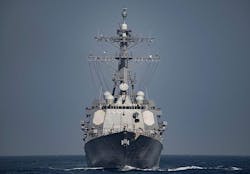Advances in periscope-hunting anti-submarine radar promises to keep the enemy's head down
THE MIL & AERO COMMENTARY – U.S. Navy surface warfare experts have invested a substantial amount of time and money over the past decade developing sensitive surface-search radar able to detect, pinpoint, and classify objects on the surface as small as a submarineperiscope.
With these advancements in systems such as the shipboard AN/SPQ-9B horizon search radar and the helicopter-based AN/APS-153 radar, enemy submarine captains might be foolish to pop their periscopes above the surface even for a second or two when U.S. Navy surface warships or anti-submarine warfare (ASW) helicopters are in the area.
One of the central programs spearheading improvements in periscope-detection radar systems is the Navy's Advanced Above Water Sensors research and development program, for which the Navy requested nearly $86 million for the current fiscal year.
The Above Water Sensors program includes the Periscope Detection Radar program, as well as the Air and Missile Defense Radar (AMDR); Dual Band Radar Upgrades; Multi-Mission Signal Processor (MMSP); the Advanced Radar Technology (ART); and the Improved Capabilities for SPY-1 Radar projects.
The Periscope Detection Radar program seeks to develop enhancements to the Navy's existing AN/SPQ-9B surface-search radar from the Northrop Grumman Corp. Electronic Systems segment in Linthicum, Md.
Related: Navy continues project to install submarine-hunting radar aboard MH-60R helicopter fleet
The AN/SPQ-9B is an X-Band, pulse Doppler, frequency agile radar with high clutter rejection for coastal waters and other high-radar-clutter environments.
The Periscope Detection Radar program is developing the Periscope Detection and Discrimination (PDD) interface for the AN/SPQ-9B radar not only to detect and classify submarine periscopes, but also to separate detected periscopes popping up just above the ocean's surface from other objects like buoys, small boats, floating mines, and even floating trash.
Separating real targets from clutter is a difficult problem that can lead to high false-alarm rates that encourage operates to disregard potential contacts. It takes sophisticated digital signal processing and painstaking modeling and simulation to find exactly the right signal characteristics that differentiate enemy periscopes from other objects on the ocean's surface.
In addition to hunting for enemy periscopes, the AN/SPQ-9B radar also can scan out to the horizon to detect low-flying fixed-wing aircraft, vessels, as well as low-flying anti-ship cruise missiles, helicopters, and unmanned aerial vehicles (UAVs).
Navy officials first tested an AN/SPQ-9B radar upgraded with the new periscope-detection interface last spring aboard the guided missile cruiser USS Lake Champlain. These tests reportedly were the culmination of almost a decade of Navy investment in developing a periscope detection mode for the AN/SPQ-9B.
story continues below
The Navy's AN/SPQ-9B radar with periscope detection and discrimination capability is not the only system at sea on the lookout for submarine periscopes. Just this week the Navy ordered 29 more AN/APS-153(V)1 automatic radar periscope detection and discrimination multi-mode radar kits in MH-60R helicopters.
The AN/APS-153(V)1 is from Telephonics Corp. in Farmingdale, N.Y. Experts from the Lockheed Martin Corp. Rotary and Mission Systems Segment in Owego, N.Y., are installing the system aboard the Navy's fleet of MH-60R helicopters.
This submarine-hunting helicopter radar is rugged, lightweight, has low-prime power, offers extremely small target detection, high-resolution imaging, and long-range surface search.
The AN/APS-153(V) provides the MH-60R and its host ship with persistent littoral and maritime domain awareness. It enables operators to classify detected moving ship targets under night and restricted visibility using its high-resolution inverse synthetic aperture radar (ISAR) mode.
ISAR enables the MH-60R to operate outside of visual and lethal range of a potential enemy and to identify detected targets when images are combined with other intelligence.
The MH-60R helicopter can send visual information from the AN/APS-153(V) to its host ship via the helicopter's C-band data link. Future upgrades to the radar may include capabilities like low probability of intercept; ISAR automatic classification aids; synthetic aperture radar; Mode 5/Mode S IFF; and weather.
Periscope-detecting radar systems like the AN/APS-153(V)1 and the AN/SPQ-9B are almost certain to encourage enemy submarines to keep their periscopes away from the surface, unless their commanders are looking for an unpleasant encounter with a Navy torpedo.
Still, keeping an attack submarine's periscope down is not guarantee of preventing a submarine torpedo attack. Modern passive sonar systems are capable of generating range and bearing information accurate enough to fire torpedoes at surface targets.
Yet forcing enemy submarines to keep their periscopes down takes away an important tool for carrying out attacks on surface shipping. Experts say that without at least a peek from a periscope, a submarine commander cannot be certain what kind of ship is on the surface, or if the vessel is friend or foe. Modern sonar is sensitive after all, but it can't detect what flag a ship might be flying.
Still, it's a good bet that surface-search radar systems like the AN/APS-153(V)1 and the AN/SPQ-9B can help mitigate the threats to Navy ships from the world's increasingly quiet and sophisticated submarines.
Learn more: search the Aerospace & Defense Buyer's Guide for companies, new products, press releases, and videos

